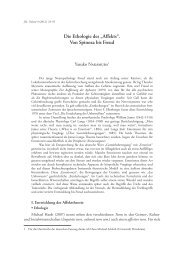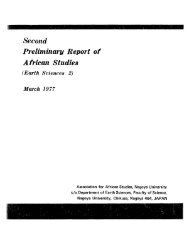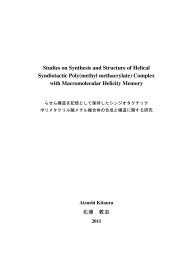Step Bunching Induced by Drift of Adatoms with Anisotropic Surface ...
Step Bunching Induced by Drift of Adatoms with Anisotropic Surface ...
Step Bunching Induced by Drift of Adatoms with Anisotropic Surface ...
You also want an ePaper? Increase the reach of your titles
YUMPU automatically turns print PDFs into web optimized ePapers that Google loves.
<strong>Step</strong> <strong>Bunching</strong> <strong>Induced</strong> <strong>by</strong> <strong>Drift</strong> <strong>of</strong> <strong>Adatoms</strong> <strong>with</strong> <strong>Anisotropic</strong> <strong>Surface</strong><br />
Diffusion<br />
Masahide Sato a nagoya]Department <strong>of</strong> Physics, Nagoya University,<br />
Furo-cho, Chikusa-ku, Nagoya 464-8602, Japan b gakushuin]Computer Center, Gakushuin University,<br />
1-5-1 Mejiro, Toshima-ku, Tokyo 171-8588, Japan ∗ , Makio Uwaha c [nagoya] and Yukio Saito d<br />
keio]Department <strong>of</strong> Physics, Keio University,<br />
3-14-1 Hiyoshi, Kohoku-ku, Yokohama 223-8522, Japan<br />
a [<br />
b [<br />
d [<br />
By means <strong>of</strong> Monte Calro simulation we study step bunching induced <strong>by</strong> the drift <strong>of</strong> adatoms <strong>with</strong> anisotropic<br />
surface diffusion. Like a vicinal face <strong>of</strong> Si(001), we suppose two types <strong>of</strong> terraces appear alternately, and their<br />
directions <strong>of</strong> fast diffusion are parallel and perpendicular to the steps. When the drift is perpendicular to the<br />
steps, we found from stability analysis that the vicinal face is unstable for pairing instability <strong>with</strong> both step-up<br />
and step-down drift. In a late stage <strong>of</strong> bunching, large bunches appear irrespective <strong>of</strong> the drift direction, while<br />
formation process <strong>of</strong> the bunches is affected <strong>by</strong> the drift direction.<br />
1. Introduction<br />
In a Si(001) vicinal face which is reconstructed<br />
to form dimer rows, two types <strong>of</strong> terraces <strong>of</strong> 1 × 2<br />
and 2 × 1 structures appear alternately and steps<br />
act as domain boundaries. When a specimen is<br />
heated <strong>by</strong> direct electric current, a vicinal face<br />
is unstable [1] and large bunches appear irrespective<br />
<strong>of</strong> the current direction [2, 3]. The type<br />
<strong>of</strong> large terraces between the bunches, however,<br />
changes: the 1 × 2 terraces appear <strong>with</strong> the stepdown<br />
current and the 2×1 terraces <strong>with</strong> the stepup<br />
current.<br />
Stability <strong>of</strong> a Si(001) vicinal face has been<br />
studied <strong>by</strong> using a one-dimensional discrete step<br />
model [4]. The cause <strong>of</strong> instability is considered<br />
to be the drift <strong>of</strong> adatoms induced <strong>by</strong> the direct<br />
electric current. When the anisotropy <strong>of</strong> surface<br />
diffusion coefficient is taken into account, pairing<br />
<strong>of</strong> steps occurs irrespective <strong>of</strong> drift direction. The<br />
type <strong>of</strong> terraces between the step pairs is determined<br />
<strong>by</strong> the drift direction. The terrace <strong>with</strong><br />
fast diffusion perpendicular to the step appears<br />
∗ present address: Department <strong>of</strong> Computational Science,<br />
Kanazawa University<br />
<strong>with</strong> the step-up drift, while the terrace <strong>with</strong> fast<br />
diffusion parallel to the step appears <strong>with</strong> the<br />
step-down drift.<br />
Behavior <strong>of</strong> steps after the pairing <strong>of</strong> steps has<br />
been studied <strong>by</strong> Natori and co-workers <strong>with</strong> a<br />
numerical simulation <strong>of</strong> the one-dimensional step<br />
model <strong>with</strong> step repulsion [5, 6]. With the stepup<br />
drift large bunches appear <strong>by</strong> coalescence <strong>of</strong><br />
step pairs. With the step-down drift the vicinal<br />
face is stable when the step distance is sufficiently<br />
small. If the step distance is large, the step<br />
pairing occurs, but large bunches do not appear,<br />
which does not agree <strong>with</strong> the experiments [2, 3].<br />
In those theoretical analyses steps are assumed<br />
impermeable for over-step diffusion <strong>of</strong> adatoms.<br />
<strong>Step</strong> permeability is known to affect the condition<br />
to induce step bunching and wandering <strong>with</strong><br />
isotropic surface diffusion [7, 8]. In this paper, <strong>by</strong><br />
carrying out a Monte Calro simulation, we study<br />
the drift-induced bunching instability <strong>of</strong> permeable<br />
steps <strong>with</strong> the anisotropic surface diffusion.<br />
We show that the bunches are formed irrespective<br />
<strong>of</strong> the drift direction in agreement <strong>with</strong> experiment.<br />
1
2. Model for Monte Calro simulation<br />
We use a square lattice model <strong>with</strong> the lattice<br />
constant (and the step height) a =1. x-axis is<br />
parallel to the steps and y-axis is in the step-down<br />
direction. Boundary conditions are periodic in<br />
the x-direction and helical in the y-direction. We<br />
forbid two-dimensional nucleation and use solidon-solid<br />
steps, i.e. the step position is a singlevalued<br />
function <strong>of</strong> x. We neglect long range stepstep<br />
interaction, but forbid overlapping <strong>of</strong> steps.<br />
There is no impingement and no evaporation <strong>of</strong><br />
adatoms.<br />
We consider two types <strong>of</strong> terraces. In one terrace,<br />
which we call terrace A, the surface diffusion<br />
is fast in the y-direction, and in the other<br />
terrace, which we call terrace B, the surface diffusion<br />
is fast in the x-direction. We choose the<br />
time increment for a diffusion trial such a way to<br />
make the surface diffusion coefficient for the fast<br />
diffusion D s = 1. We assume that the drift <strong>of</strong><br />
adatoms is in the y-direction. In the terrace B,<br />
an adatom on the site (i, j) movesto(i ± 1,j)<br />
<strong>with</strong> the probability 1/4 andto(i, j ± 1) <strong>with</strong> the<br />
probability p(1±Fa/2k B T )/4, where p and F represent<br />
the anisotropy <strong>of</strong> the surface diffusion and<br />
the external force that induces the drift. In the<br />
terrace A, an adatom on the site (i, j) movesto<br />
(i ± 1,j) <strong>with</strong> the probability p/4 andto(i, j ± 1)<br />
<strong>with</strong> (1 ± Fa/2k B T )/4. We assume two types <strong>of</strong><br />
terraces appear alternately and the steps are permeable<br />
[7—9]. The diffusion between neighboring<br />
terraces occurs <strong>with</strong> the transition probability <strong>of</strong><br />
the upper side terrace.<br />
When an adatom comes in front <strong>of</strong> a step, solidification<br />
<strong>of</strong> the adatom occurs <strong>with</strong> the probability<br />
[8]<br />
p s =<br />
∙<br />
1+exp<br />
µ ∆Es − φ<br />
k B T<br />
¸<br />
, (1)<br />
where ∆E s is the increment <strong>of</strong> the step energy<br />
and φ the chemical potential gain <strong>by</strong> the solidification.<br />
When there is no adatom on the top <strong>of</strong><br />
a step atom, melting <strong>of</strong> the atom occurs <strong>with</strong> the<br />
probability<br />
∙ µ ¸−1 ∆Es + φ<br />
p m = 1+exp<br />
. (2)<br />
k B T<br />
3. Result <strong>of</strong> simulation<br />
In our simulation the system size is 128 × 128,<br />
the step number is 32, p =1/2 andFa/k B T =<br />
±0.3 (+(−) indicates the step-down (step-up) direction).<br />
Figure 1 represents snap shots <strong>of</strong> the<br />
step bunching. The upper (smaller y) sideterrace<br />
<strong>of</strong> a solid line is the terrace A and that <strong>of</strong><br />
a dotted line is the terrace B. Pairing <strong>of</strong> steps<br />
occurs irrespective <strong>of</strong> the drift direction((a) and<br />
(b)). The type <strong>of</strong> the large terrace separating<br />
step pairs changes <strong>with</strong> the drift direction: the<br />
step pairs are separated <strong>by</strong> the terrace A <strong>with</strong><br />
the step-down drift (a) and <strong>by</strong> the terrace B <strong>with</strong><br />
the step-up drift (b).<br />
Figures 1 (c) and (d) represent snap shots <strong>of</strong><br />
the step bunching in a late stage. Irrespective <strong>of</strong><br />
the drift direction, the large bunches appear periodically.<br />
The wandering fluctuation <strong>of</strong> the large<br />
bunches <strong>with</strong> the step-down drift is weaker than<br />
that <strong>with</strong> the step-up drift. There are straight<br />
step pairs in the large terraces in (c) and no free<br />
steps in (d).<br />
The difference <strong>of</strong> the formation process <strong>of</strong><br />
bunches is shown in Fig. 2, which represents<br />
the time evolution <strong>of</strong> the average step positions.<br />
When the drift is in the step-down direction (<br />
Fig. 2(a)), in the initial stage the step pairs appear<br />
and terrace A spreads. The train <strong>of</strong> step<br />
pairs is also unstable and step bunches are produced<br />
<strong>by</strong> the coalescence <strong>of</strong> step pairs. In a late<br />
stage, the coalescence and separation <strong>of</strong> a receding<br />
step pair <strong>with</strong> advancing large bunches are<br />
repeated.<br />
When the drift is in the step-up direction (Fig.<br />
2(b)), the step pairing occurs in the initial stage,<br />
which is similar to that <strong>with</strong> the step-down drift<br />
except that the dominant terraces are terrace B.<br />
In a late stage large bunches appear as a result<br />
<strong>of</strong> successive coalescence <strong>of</strong> bunches and there are<br />
few free step pairs (one pair in Fig. 2(b)), which<br />
repeat coalescence and separation, but the pair<br />
moves to the opposite direction compared to (a).<br />
4. Summary and discussion<br />
In this paper, <strong>by</strong> carrying out a Monte Calro<br />
simulation, we studied the bunching instability<br />
2
(a)<br />
(b)<br />
(c)<br />
(d)<br />
Figure 1. Snap shots <strong>of</strong> step bunching <strong>with</strong> anisotropic surface diffusion: (a) <strong>with</strong> the step-down drift and<br />
(b) <strong>with</strong> the step-up drift in an initial stage, and (c) <strong>with</strong> the step-down drift and (d) <strong>with</strong> the step-up<br />
drift in a late stage.<br />
(a)<br />
(b)<br />
Figure 2. Time evolution <strong>of</strong> step bunching (a) <strong>with</strong> the step-down drift and (b) <strong>with</strong> the step-up drift.<br />
3
induced <strong>by</strong> the drift <strong>of</strong> adatoms <strong>with</strong> taking account<br />
<strong>of</strong> the anisotropic surface diffusion. In the<br />
initial stage <strong>of</strong> the instability, pairing <strong>of</strong> steps occurs.<br />
The result agrees <strong>with</strong> the previous stability<br />
analysis [4] although the step permeability is different.<br />
In a late stage <strong>of</strong> the instability, large bunches<br />
appear irrespective <strong>of</strong> the drift direction, while<br />
the type <strong>of</strong> the dominant terraces changes <strong>with</strong><br />
the drift direction: terrace A <strong>with</strong> the stepdown<br />
drift and terrace B <strong>with</strong> the step-up drift.<br />
The result differs from the previous theoretical<br />
study [5, 6] where impermeability was assumed.<br />
In our simulation we have assumed steps are permeable<br />
[7—9], and this difference seems the origin<br />
<strong>of</strong> the discrepancy. Considering the direction<br />
<strong>of</strong> fast diffusion [10, 11] and that the drift is<br />
in the current direction [12], our results qualitatively<br />
agree <strong>with</strong> the experiments in Si(001) [1—3],<br />
which might imply that the steps are permeable.<br />
Sincewehavealsoassumedthesamestepkinetics<br />
for the two kinds <strong>of</strong> steps, we cannot make<br />
adefinite conclusion for the step permeability in<br />
Si(001) yet.<br />
6 A. Natori, H. Fujimura and M. Fukuda, Appl.<br />
Surf. Sci. 60/61 (1992) 85.<br />
7 S. Stoyanov, Surf. Sci. 416 (1998) 200.<br />
8 M. Sato, M. Uwaha and Y. Saito, Phys. Rev.<br />
B 62 (2000) 8452.<br />
9 S. Tanaka, N. C. Bartelt, C. C. Umbach, R.<br />
M.Tromp,andJ.M.Blackley,Phys.Rev.<br />
Lett. 78 (1997) 3342.<br />
10 M. Ichikakwa, T. Doi, Appl. Phys. Lett. 60<br />
(1992) 1082.<br />
11 J. J. Métois, J. C. Heyraud, A. Pimpinelli,<br />
Surf. Sci. 420 (1999) 250.<br />
12 M. Degawa, H. Minoda, Y. Tanishiro, and K.<br />
Yagi, Surf. Sci. 461 (2000) L528.<br />
acknowlegements<br />
This work was performed as a part <strong>of</strong> the program<br />
“Research for the Future” <strong>of</strong> the Japanese<br />
Society for the Promotion <strong>of</strong> Science and was<br />
supported <strong>by</strong> a Grant-in-Aid from the Ministry<br />
<strong>of</strong> Education <strong>of</strong> Japan. The authors benefited<br />
from the inter-university co-operative research<br />
program <strong>of</strong> the Institute for Materials Research,<br />
Tohoku University.<br />
REFERENCES<br />
1 H. Kahara and K. Yagi, Jpn. J. Appl. Phys.<br />
28 (1989) 1042.<br />
2 L. V. Litvin, A. B. Krasilnikov and A. V.<br />
Latyshev, Surf. Sci. Lett. 244 (1991) L121.<br />
3 A.V.Latyshev,L.V.Litvin,A.L.Aseev,<br />
Appl. Surf. Sci. 130 (1998) 139.<br />
4 S. Stoyanov, Jpn. J. Appl. Phys. 29 (1990)<br />
L659.<br />
5 A. Natori, H. Fujimura and H. Yasunaga,<br />
Jpn. J. Appl. Phys. 31 (1992) 1164.<br />
4









